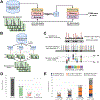ProteoStorm: An Ultrafast Metaproteomics Database Search Framework
- PMID: 30268435
- PMCID: PMC6231400
- DOI: 10.1016/j.cels.2018.08.009
ProteoStorm: An Ultrafast Metaproteomics Database Search Framework
Abstract
Shotgun metaproteomics has the potential to reveal the functional landscape of microbial communities but lacks appropriate methods for complex samples with unknown compositions. In the absence of prior taxonomic information, tandem mass spectra would be searched against large pan-microbial databases, which requires heavy computational workload and reduces sensitivity. We present ProteoStorm, an efficient database search framework for large-scale metaproteomics studies, which identifies high-confidence peptide-spectrum matches (PSMs) while achieving a two-to-three orders-of-magnitude speedup over popular tools. A reanalysis of a urinary tract infection (UTI) dataset of 110 individuals revealed a complex pattern of polymicrobial expression, including sub-types of UTIs, cases of bacterial vaginosis, and evidence of no underlying disease. Importantly, compared to the initial UTI study that restricted the search database to a manually curated list of 20 genera, ProteoStorm identified additional genera that were previously unreported, including a case of infection with the rare pathogen Propionimicrobium.
Keywords: LC-MS/MS; metaproteomics; microbial communities; microbiology; proteome informatics; proteomics.
Copyright © 2018 Elsevier Inc. All rights reserved.
Conflict of interest statement
Declaration of Interests
V.B. is a cofounder, has an equity interest in, and receives income from Digital Proteomics, LLC. The terms of this arrangement have been reviewed and approved by the University of California, San Diego, in accordance with its conflict-of-interest policies. Digital Proteomics was not involved in the research presented here.
Figures


References
-
- Burke MC, Mirokhin YA, Tchekhovskoi DV, Markey SP, Heidbrink Thompson J, Larkin C, and Stein SE (2017). The Hybrid Search: A Mass Spectral Library Search Method for Discovery of Modifications in Proteomics. J Proteome Res 16, 1924–1935. - PubMed

